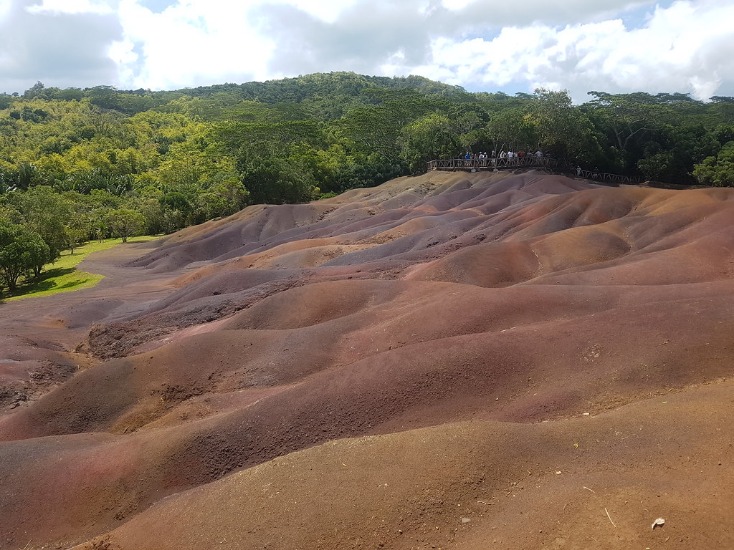Overview of the 7 Colored Earth
The 7 Colored Earth in Mauritius is a captivating natural phenomenon known for its vibrant, multi-hued sand dunes. Located in the Chamarel region, this unique geographic feature showcases a striking display of seven distinct colors, ranging from red and brown to purple and green. Visitors are fascinated by the surreal landscape, which remains a mystery in terms of its formation and the geological processes behind it. The 7 Colored Earth is not only a popular tourist attraction but also a symbol of the island’s rich natural heritage and diverse ecosystem.
Geographical Location
The 7 Colored Earth of Mauritius is a famous natural phenomenon known for its stunning vibrant hues and unique geological formations. Located in the Chamarel village, this attraction showcases sand dunes with seven distinct colors, ranging from red and brown to purple, green, and blue. The site is a popular destination for tourists interested in natural wonders and geological marvels. It is believed that the colors result from the volcanic activity and mineral richness in the area. The 7 Colored Earth is a protected site, offering visitors a chance to observe the beautiful, naturally occurring rainbow of sand hues in a picturesque setting. Its geographical location in the southwestern part of Mauritius makes it easily accessible for travelers exploring the island’s diverse attractions.
Historical Significance
The 7 Colored Earth of Mauritius is a natural phenomenon renowned for its vibrant, multi-colored soil formations. Located in Chamarel village, this geological wonder showcases hues of red, brown, violet, green, and blue, creating a captivating landscape that attracts numerous visitors each year.
Historically, the 7 Colored Earth is believed to have formed millions of years ago through volcanic activity, which resulted in distinct mineral deposits that settled into the distinctive colors we see today. It holds cultural and geological significance, representing the island’s volcanic origins and natural diversity.
This site has become an important symbol of Mauritius’s natural heritage, highlighting the island’s unique volcanic past. The colorful terrain has also contributed to the local tourism industry, making it an essential part of the island’s identity and a popular destination for both nature lovers and history enthusiasts alike.
Formation and Geological Background
The 7 Colored Earth of Mauritius is a stunning natural phenomenon characterized by vibrant, multi-hued sand dunes that create a captivating landscape. This unique geological feature is located in Chamarel, a small village in the southwestern part of the island. The colorful dunes are renowned for their striking appearance, with hues ranging from red, brown, and purple to green, blue, and yellow, making it a popular tourist attraction.
The formation of the 7 Colored Earth is primarily due to volcanic activity that occurred millions of years ago. The region’s volcanic origins are evident in the mineral-rich basaltic rocks that have subsequently weathered over time. The various colors result from the oxidation and mineral content within the sands, including iron, aluminum, and other elements. These minerals have undergone differential weathering processes, leading to the distinct colored layers that are visible today.
Geologically, the area is part of the volcanic massif of Mauritius, which was formed during a series of volcanic eruptions about 8 to 10 million years ago. The mineral composition and the weathering effects of rainwater and wind have further shaped the dunes into their present form. The unique terrain is a testament to the island’s volcanic history and the natural geological processes that have created this rare and beautiful phenomenon.
Colors and Composition
Colors and composition play a vital role in shaping the visual appeal and cultural significance of landscapes around the world. In the context of 7 Colored Earth in Mauritius, vibrant hues and intricate mineral formations create a mesmerizing landscape that captures the imagination. These natural color variations not only highlight the earth’s geological diversity but also contribute to the unique charm of this famous destination. Understanding the interplay of colors and composition helps visitors appreciate the geological marvels that make 7 Colored Earth a remarkable site to explore.
Red Section
The Red Section of the 7 Colored Earth in Mauritius showcases a stunning expanse of rich, rusty hues that contrast beautifully with the surrounding colorful layers. This segment highlights the natural mineral deposits that give the soil its vibrant red tones, creating a striking visual effect. The composition emphasizes the harmonious blend of colors and textures, inviting visitors to appreciate the unique geological features of the site. The vivid red soil stands out prominently, adding depth and diversity to the palette of the seven colored earth formations. Overall, the interplay of colors in this section exemplifies the natural artistry inherent in Mauritius’s geological landscape.
Green Section
The Green Section of the 7 Colored Earth in Mauritius showcases a stunning display of vibrant green hues, blending naturally with the surrounding lush landscapes. This area is distinguished by its rich vegetation that complements the mineral-rich terrain, creating a harmonious contrast of colors. The diverse composition of the green earth features various shades of emerald and forest green, highlighting the area’s ecological richness. The interplay of colors in this section emphasizes the unique geological formation while adding to the overall visual appeal of the site. Visitors can enjoy the striking greenery as part of the mesmerizing spectrum that makes the 7 Colored Earth a truly remarkable natural wonder.
Violet Section
The Violet Section of the Colors and Composition in the 7 Colored Earth of Mauritius features rich, deep hues that evoke a sense of mystery and serenity. This section showcases vibrant violet and purple tones that seamlessly blend with neighboring colors, creating a captivating visual palette. The composition highlights the natural mineral deposits responsible for these striking shades, emphasizing the earth’s unique geological formation. The harmonious arrangement of violet gradients enhances the overall aesthetic, making it a prominent and alluring part of the colorful landscape.
Yellow and Purple Sections
The yellow and purple sections of the 7 Colored Earth in Mauritius offer a striking visual contrast that highlights the island’s natural beauty. The vibrant yellow hues evoke warm, sunny feelings, while the purple tones add a sense of depth and mystery to the landscape. These colors are carefully arranged and shaped by nature’s forces, creating a captivating composition that draws visitors’ attention. The interplay of these vivid colors enhances the overall aesthetic and emphasizes the unique geological formation of this UNESCO World Heritage site. Visitors are often captivated by how the diverse colors blend harmoniously within the landscape, showcasing the incredible richness of Mauritius’s natural environment.
Other Colors Present
Colors and composition play a vital role in the unique visual appeal of the 7 Colored Earth in Mauritius. This natural phenomenon showcases a vibrant palette of hues that captivate visitors and highlight the geological diversity of the site. The composition of the earth comprises mineral-rich soils that have been naturally colored over centuries, creating a stunning mosaic of colors. In addition to the main colors, several other shades are present, adding to the earth’s mesmerizing landscape.
- Red: Due to iron oxide content, giving parts of the terrain a lively red hue.
- Green: From the presence of minerals like chlorite and other greenish minerals.
- Blue: A rare blue tint caused by specific mineral compositions or environmental factors.
- Yellow: Resulting from the oxidation of certain minerals, adding a bright yellow tone.
- Brown: Derived from decomposed organic materials and weathered minerals.
- Violet: A subtle violet shade emerging from mineral variations within the soil.
- Pink: Appearing in certain areas, attributed to the specific mineral blend and natural pigmentation.
These diverse colors are a testament to the complex geological history of the area, making the 7 Colored Earth in Mauritius a truly enchanting and colorful natural wonder.
Tourist Attractions and Accessibility
Visiting the 7 Colored Earth in Mauritius is a unique experience that offers both natural beauty and cultural significance. Accessibility plays a crucial role in ensuring that travelers of all abilities can enjoy this stunning geological site. From well-maintained paths to informative facilities, efforts have been made to make the 7 Colored Earth accessible to everyone, allowing visitors to fully appreciate its vibrant hues and breathtaking landscape.
Visiting the 7 Colored Earth
The 7 Colored Earth in Mauritius is a stunning natural wonder renowned for its vibrant, multi-colored sand dunes. Visitors can enjoy the unique scenery and take memorable photographs of the vividly hued landscapes. Access to the site is convenient, with well-maintained roads leading directly to the attraction, making it easily reachable by car or tour groups. The site is equipped with pathways and viewing platforms that accommodate travelers of all ages and mobility levels. Overall, the 7 Colored Earth offers a captivating experience for tourists seeking both natural beauty and accessibility in their visit to Mauritius.
Activities and Tours
7 Colored Earth Mauritius is a captivating natural attraction renowned for its vibrant, multicolored soil formations that draw visitors from around the world. Accessible via the Chamarel village in the southwest of the island, the site offers convenient parking and well-maintained pathways for visitors of all ages and physical abilities.
Visitors can immerse themselves in the stunning visual spectacle of the seven distinct colors of earth, created by the natural mineral deposits in the soil. The site also includes a small museum and a viewpoint overlooking the plains, providing excellent photo opportunities and insight into the geological history of the area.
There are various activities and tours available for guests, including guided walks that explain the formation and significance of the colored earth. Many tour operators offer excursions that combine a visit to Chamarel with nearby attractions such as the Chamarel Waterfall, the Rhumerie de Chamarel distillery, and other natural and cultural sites in Mauritius. Engaging in these tours allows visitors to explore the region comprehensively and enjoy the diverse beauty of the island.
Facilities and Amenities
The Seven Colored Earths in Mauritius is a stunning natural phenomenon that attracts many visitors each year. Located in Chamarel, this unique geological formation features sand dunes composed of seven distinct colors, creating a mesmerizing landscape that is both accessible and easy to explore. There are well-maintained pathways for visitors to walk around and appreciate the vibrant hues up close.
Facilities and amenities at the site include visitor centers with informative displays about the formation, guided tours, and designated viewing platforms. Restrooms and refreshment kiosks are conveniently available nearby, ensuring a comfortable experience. The site is wheelchair accessible, with ramps and smooth pathways to accommodate all visitors, making it inclusive for everyone to enjoy the spectacular scenery of Mauritius’ natural wonder.
Best Time to Visit
7 Colored Earth Mauritius is a captivating geological formation located in Chamarel, offering visitors a unique and vibrant experience. The site is easily accessible by car and is equipped with pathways and viewing platforms to ensure a comfortable visit for all travelers. Nearby facilities include parking areas, souvenir shops, and refreshment stalls, making the experience both convenient and enjoyable. The best time to visit is during the cooler months between May and October when the weather is pleasant, and the natural colors are most vivid. Visiting during this period allows travelers to fully appreciate the stunning landscape without the inconvenience of heavy rain or intense heat.
Cultural and Mythological Significance
Cultural and mythological significance often enriches the beauty and allure of natural wonders, connecting them deeply to the heritage and beliefs of local communities. The seven-colored earth of Mauritius is not only a striking geological formation but also a symbol of cultural identity and mythological stories that have been passed down through generations. These vibrant hues reflect a harmony between nature and tradition, inviting visitors to explore both its physical beauty and its spiritual tales.
Local Legends and Folklore
The 7 Colored Earth of Mauritius holds a rich cultural and mythological significance that is deeply intertwined with local legends and folklore. This natural wonder is believed to be the result of ancient mystical forces, and various stories have been passed down through generations that explain its unique multicolored dunes. According to folklore, the vibrant hues of the earth are linked to the mystical powers of ancestral spirits who, centuries ago, blessed the land with their magical energies. Many locals see the site as a sacred place, often associating it with deities and supernatural beings that protect the island’s natural treasures. The 7 Colored Earth has also become a symbol of Mauritius’s diverse cultural heritage, reflecting the fusion of different traditions and beliefs that shape the island’s identity. Tales of the earth’s changing colors and its hidden secrets continue to inspire wonder and reverence among residents and visitors alike, reinforcing its status as a mystical and culturally significant site.
Impact on Local Community
The 7 Colored Earth of Mauritius holds a profound cultural and mythological significance for the local community, serving as both a natural wonder and a symbol of the island’s rich heritage. This unique geological formation is steeped in local legends and myths that enhance its mystique and cultural value.
- According to local folklore, the seven distinct colors of the earth represent the seven ancient families of Mauritius, symbolizing unity and diversity within the community.
- Many residents believe that the site is enchanted, with legends claiming that fairies and spirits inhabit the colorful sands, adding spiritual importance to the location.
- The site is often featured in cultural festivals and storytelling sessions, emphasizing its role in preserving oral traditions and fostering community identity.
- Tourists and locals alike see the 7 Colored Earth as a sacred landmark, encouraging communal pride and cultural continuity.
Conservation and Environmental Impact
Conservation and environmental impact are vital topics that highlight the importance of protecting our natural resources and ecosystems. As we explore unique attractions like the 7 Colored Earth in Mauritius, it becomes essential to understand how such natural wonders are preserved and the significance of minimizing our ecological footprint. Ensuring the sustainability of these remarkable sites helps maintain biodiversity and promotes environmental awareness for future generations.
Protection Efforts
The 7 Colored Earth of Mauritius is a stunning natural phenomenon that highlights the importance of conservation efforts to preserve unique geological formations. Protecting this site ensures that future generations can witness its vibrant hues and learn about the Earth’s natural processes. Environmental impact initiatives focus on minimizing human interference, maintaining the area’s stability, and preventing erosion that could threaten the colorful sands. Conservation programs also promote sustainable tourism, encouraging visitors to appreciate the site responsibly while supporting local communities. Ongoing protection efforts are essential to safeguard the 7 Colored Earth as a natural wonder and a symbol of Mauritius’s rich environmental heritage.
Environmental Challenges
The 7 Colored Earth of Mauritius is a remarkable natural phenomenon that highlights the importance of conservation and understanding environmental impacts. This unique geological formation attracts many visitors, but it also underscores the need to protect such delicate ecosystems from environmental challenges that could threaten their existence.
- Overtourism can lead to habitat destruction, soil erosion, and pollution, which threaten the sustainability of the 7 Colored Earth.
- Climate change poses a risk by altering weather patterns, potentially affecting the colors and stability of the mineral deposits.
- Unregulated development in surrounding areas can cause environmental degradation and compromise the integrity of the site.
- Pollution from nearby industries and agricultural activities can contaminate the soil and water, impacting local flora and fauna.
- Lack of awareness and insufficient conservation efforts may lead to neglect and deterioration of this natural treasure.
- Implementing strict regulations regarding tourism to minimize ecological footprints.
- Promoting environmental education to raise awareness about the importance of conservation.
- Developing sustainable practices for land use and visitor management.
- Monitoring environmental changes through scientific research to inform conservation strategies.
- Encouraging community involvement in preservation efforts to foster a sense of shared responsibility.
Sustainable Tourism Initiatives
The 7 Colored Earth of Mauritius is a stunning natural wonder that emphasizes the importance of conservation and sustainable tourism. Preserving this unique geological formation requires responsible practices that minimize environmental impact and promote ecological awareness among visitors. Sustainable tourism initiatives focus on educating tourists about the significance of the site, encouraging eco-friendly behaviors, and supporting local communities through responsible visitor management and eco-tourism projects. These efforts help ensure that the beautiful, multicolored sands remain protected for future generations to enjoy while contributing to the sustainable development of Mauritius’s tourism industry.





0 Comments